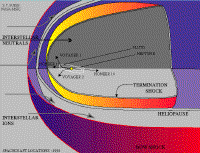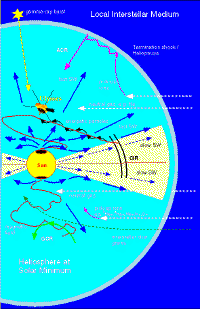The heliosphere
The boundary with interstellar space
The heliosphere breathes with the solar wind
The heliosphere
If you could leave the Earth and travel vertically through its atmosphere, you may expect eventually to reach empty space - a void of darkness where nothing exists. The space around the Earth, however, is far from empty. Charged particles (electron and ions) streaming away from the Sun envelop our planet and its neighbours in a magnetic bubble. "The heliosphere is the bubble this solar wind blows out into the local interstellar medium. It defines the volume of space over which our Sun's influence predominates," says Richard Marsden, Ulysses project scientist at ESA's technical centre, ESTEC in the Netherlands.
That influence reaches way beyond what we normally think of as the solar system. The closest boundary of the heliosphere is thought to extend about 100 AU out from the Sun, that is 100 times the distance of the Earth from the Sun and at least twice as far out as the Kuiper belt, which contains the most distant objects in the solar system. NASA's two Voyager spacecraft are expected to reach this boundary before they finally grow too old to transmit signals in about 2020.
Figure 1. Diagram of the heliosphere (NASA)
 A protective bubble
A protective bubble
As the heliosphere determines the environment in which the solar system, including our planet exists, its study is assuming ever greater importance. Without it, we probably wouldn't be here. It shields us from cosmic rays, very energetic particles generated far away in the universe, that would otherwise bombard the Earth continuously, causing damage to living cells. "Without the heliosphere, life would certainly have evolved differently - and maybe not at all," says Marsden.
The heliosphere's protective bubble is formed by the solar wind and the magnetic fields that it drags out into space. The existence of the solar wind was first put forward by Ludwig Biermann in 1951, who suggested that comet tails are always directed away from the Sun because they are pushed by a continuous flow of charged particles streaming out from the Sun. It was already known that the Sun's atmosphere, or corona, is very hot - a million degrees or more - and in 1957 Sydney Chapman showed that it should extend far out into space. One year later, Eugene Parker, the "father" of the solar wind, proposed that this hot corona not only extends far into space, but escapes the Sun's gravity as a "supersonic" wind, dragging the solar magnetic field with it as it expands. His ideas were greeted with scepticism initially, but supporting evidence soon followed from space probes.
This stream of outflowing particles, however, is far from uniform or constant: it comes in two varieties, "fast" (about 750 km/s) and "slow" (350 to 400 km/s), which vary with solar latitude and level of solar activity. During periods of low activity, the fast wind emanates from the poles and the slow wind from near the equator. Ulysses found that they meet at a clearly defined boundary (see Findings). Somewhat counter-intuitively, the fast wind comes from relatively cool gaps in the corona, called coronal "holes" and the slow wind from hotter coronal "streamers". During periods of low activity, holes tend to develop around the poles and streamers around the equator. But during high activity, the pattern of holes and streamers becomes more jumbled. The Ulysses team expects to find a blurred boundary between the fast and slow solar wind during the forthcoming solar maximum.
 The boundary with interstellar space
The boundary with interstellar space
As the strength and level of activity of the solar wind varies in space and time, so does the size and behaviour of the heliosphere. It would probably extend outwards from the Sun indefinitely if the solar wind did not come up against a barrier, a conflicting stream of charged particles coming from interstellar space. "Interstellar space isn't empty. It seems we're at the edge of an interstellar cloud which is moving independently of the rotation of the Milky Way galaxy," says Marsden. The solar wind is brought to a halt when the pressure of its outward flow is matched by that exerted by the local interstellar medium (LISM).
Although the solar wind bears little resemblance to the winds we experience in our atmosphere on Earth, its behaviour when encountering an obstacle, such as a planet or the boundary with the LISM, is similar to that of the air around an aircraft flying faster than the speed of sound. Sound waves, which are pressure waves, build up in front of the aircraft nose because the aircraft is travelling faster than they can escape. To keep the air flowing around the spacecraft, the pressure build-up undergoes an abrupt change and a so-called "shock" wave is formed. When the shock wave reaches the ground, an observer hears a sonic boom.
The "supersonic" solar wind sees the LISM boundary as an obstacle, just like the aircraft in the Earth's atmosphere. The solar wind has to slow down so that it can flow along the boundary and it makes the sudden change by creating a shock wave called the "termination shock". Closer to home, a shock wave is formed when the solar wind meets the Earth's magnetic field lines. This interaction creates a magnetosphere around the Earth, or any other planet with a magnetic field.
Figure 2. LISM interaction with heliosphere
The termination shock wave will be the first signal that the Voyager spacecraft are approaching the heliosphere-LISM boundary, or heliopause. Beyond the termination shock, the solar wind will travel at subsonic speed for some distance before it finally mingles with the LISM. The heliopause is the final boundary, which will be marked by an increase in the number of slow cosmic rays as the spacecraft moves out of the solar wind and into interstellar space. If the LISM is travelling supersonically with respect to the Sun, there could also be another shock wave further out as the LISM slows down to subsonic speeds.
The shape of the heliosphere is not symmetrical around the Sun. The motion through the LISM compresses it at the front, and drags it out into a tail at the back, very much like a planetary magnetosphere. The distance of the leading edge from the Sun is far less than that to the end of the heliotail. Fortunately, the Voyager spacecraft are travelling in the direction of the leading edge.
The Sun is not the only star to form a heliosphere. Stellar winds are thought to be common and there is firm evidence for "asterospheres" surrounding several of our closest stellar neighbours, including Sirius and Alpha Centauri.
 The heliosphere breathes with the solar wind
The heliosphere breathes with the solar wind
Changes in conditions in the solar wind produce changes in the size and shape of the magnetospheres around the planets and of the heliosphere. "The distance of the heliopause from the Sun changes as the heliosphere breathes in and out on the timescale of the solar cycle," says Marsden - which means it could now be expanding away from the Voyager spacecraft as the solar cycle approaches its maximum in the autumn of 2000.
Because the solar wind is magnetised, its presence is felt by all charged particles, making it difficult for them to enter the heliosphere. To the neutral atoms that make up a significant part of the local interstellar cloud, however, the solar wind is largely invisible. Affected only by gravity and the pressure of sunlight, many of these neutrals are able to penetrate far into the heliosphere before finally interacting with a charged particle in the solar wind and becoming ionised by losing an electron. They then start a new life as so-called "pick-up ions", becoming embedded in the expanding solar wind. Measurements of interstellar gas, either directly as neutral atoms, or indirectly as pick-up ions, can provide information about the LISM surrounding the heliosphere, as well as conditions at the boundary itself.
Ulysses has made ground-breaking contributions in this area with the first ever direct measurement of neutral helium and extensive measurements of a wide range of previously undetected pick-up ions. With these observations, scientists have been able to identify the particular local interstellar cloud in which the Sun resides.
Once they have been converted into pick-up ions, interstellar gas atoms can take on a third identity, masquerading as cosmic rays. The pick-up ions interact with the termination shock, which acts as a huge accelerator. They then travel back towards the Sun, mimicking galactic cosmic rays. They have been given the name "anomalous" cosmic rays.
One of Ulysses discoveries during its first five years of life, was how galactic and anomalous cosmic rays penetrating the inner heliosphere, are so disturbed by the jumble of magnetic field lines they encounter, that they are distributed evenly in space and do not home in on the solar poles as previously expected. Another major result was that the fast solar wind predominates during the solar minimum: before Ulysses, the slow wind was thought to predominate and the fast wind was thought to be somewhat unusual. Yet a further discovery was of dust particles in the heliosphere that have come from the local interstellar cloud (for further information on Ulysses discoveries (see Findings).
 Useful links
Useful links
News article: The Heliosphere is tilted - implications for the 'Galactic weather forecast'?
SOHO science: Solar wind and alien atoms


